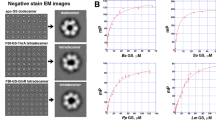Abstract
In the photosynthetic bacterium Rhodopseudomonas capsulata, NH +4 switch-off of nitrogenase activity can be mimicked by its analog, methylamine. Like NH +4 , methylamine appeared to require processing by glutamine synthetase (GS) before it was effective; γ-glutamylmethylamide was shown to be the product of this reaction. Evidence that this glutamine analog functioned directly to initiate nitrogenase inactivation was suggested first by the fact that it was a poor substrate for glutamate synthase (i.e., it was not further metabolized by this pathway) and secondly, azaserine which blocks the transfer of the glutamine amide group had no effect on CH3NH +3 (or NH +4 ) switch-off. These observations are taken as preliminary evidence to suggest that when NH +4 inhibits nitrogenase activity, inactivation is initiated by glutamine itself, and not a molecule derived from it. Finally, evidence was presented that R. capsulata would use CH3NH +3 as a nitrogen substrate, but lag periods and generation times increased with subsequent passages.
Similar content being viewed by others
References
Bicknell B, Owens JD (1980) Utilization of methyl amines as nitrogen sources by non-methylotrophs. J Gen Microbiol 117:89–96
Brown CM, Herbert RA (1977) Ammonia assimilation in members of the Rhodospirillaceae. FEMS Microbiol Lett 1:43–46
Falk G, Johansson BC, Nordlund S (1982) The role of glutamine synthetase in the regulation of nitrogenase activity (“switch of” effect) in Rhodospirillum rubrum. Arch Microbiol 132:251–253
Gotto JW, Yoch DC (1982) Regulation of Rhodospirillum rubrum nitrogenase activity: Interconversion of active and inactive Fe protein. J Biol Chem 257:2868–2873
Hallenbeck PC, Meyer CM, Vignais PM (1982) Nitrogenase from the photosynthetic bacterium Rhodopseudomonas capsulata: Purification and molecular properties. J Bacteriol 149:708–717
Hartman SC (1973) Relationships between glutamine amidotransferases and glutaminases. In: Prusiner S, Stadtman ER (eds) The enzymes of glutamine metabolism. Academic Press Inc New York, pp 319–330
Hillmer P, Gest H (1977) H2 metabolism in the photosynthetic bacterium Rhodopseudomonas capsulata: Production and utilization of H2 by resting cells. J Bacteriol 129:732–739
Jones BL, Monty KL (1979) Glutamine as a feedback inhibitor of the Rhodopseudomonas sphaeroides nitrogenase system. J Bacteriol 139: 1007–1013
Kleiner D (1981) The transport of NH3 and NH +4 across biological membranes. Biochim Biophys Acta 639:41–52
Kleiner D, Fitzke E (1981) Some properties of a new electrogenic transport system: The ammonium (methylammonium) carrier from Clostridium pasteurianum. Biochim Biophys Acta 641:138–147
Kung, H-F, Wagner C (1969) γ-Glutamylmethylamide: a new intermediate in the metabolism of methylamine. J Biol Chem 244: 4136–4140
Ludden PW, Burris RH (1976) Activating factor for the iron protein of nitrogenase from Rhodospirillum rubrum. Science 19:424–426
Ludden PW, Burris RH (1979) Reinoval of an adenine-like molecule during activation of dinitrogenase reductase from Rhodospirillum rubrum. Proc Natl Acad Sci USA 76:6201–6205
Meers JL, Tempst DW, Brown CM (1970) Glutamine (amide) 2-oxglutarate amino transferase oxido-reductase (NADP), an enzyme involved in synthesis of glutamate by some bacteria. J Gen Microbiol 64:187–194
Meister A (1962) Glutamine synthetase. In: Boyer PD, Lardy H, Myrbäck KM (eds) The enzymes, 2nd ed, vol 6. Academic Press, New York, pp 443–468
Nordlund S, Eriksson U, Baltscheffsky H (1977) Necessity of a membrane component for nitrogenase activity in Rhodospirillum rubrum. Biochim Biophys Acta 462:187–195
Ormerod JG, Ormerod KS, Gest H (1961) Light-dependent utilization of organic compounds and photoproduction of molecular hydrogen by photosynthetic bacteria: Relationships with nitrogen metabolism. Arch Biochem Biophys 94:449–463
Quayle JR (1972) The metabolism of one-carbon compounds by microorganisms. In: Rose AH, Tempest DW (eds) Advances in microbial physiology, vol 7. Academic Press, New York, pp 119–203
Ronzio RA, Rowe WB, Meister A (1969) Studies on the mechanism of inhibition of glutamine synthetase by methionine sulfoximine. Biochemistry 8:1066–1075
Shapiro BM, Stadtman ER (1970) Glutamine synthetase (Escherichia coli). In: Tabor H, Tabor CW (eds) Meth. enzymol, vol 17A. Academic Press, New York, pp 910–922
Yelton MM, Yoch DC (1981) Nitrogen metabolism in Rhodospirillum rubrum: Characterization of glutamate synthase. J Gen Microbiol 123:335–342
Yoch DC, Gotto JW (1982) Effect of light intensity and inhibitors of nitrogen assimilation of NH +4 inhibition of nitrogenase activity in Rhodospirillum rubrum and Anabaena sp. J Bacteriol 151:800–806
Author information
Authors and Affiliations
Rights and permissions
About this article
Cite this article
Yoch, D.C., Zhang, Zm. & Claybrook, D.L. Methylamine metabolism and its role in nitrogenase “Switch off” in Rhodopseudomonas capsulata . Arch. Microbiol. 134, 45–48 (1983). https://doi.org/10.1007/BF00429405
Received:
Accepted:
Issue Date:
DOI: https://doi.org/10.1007/BF00429405




